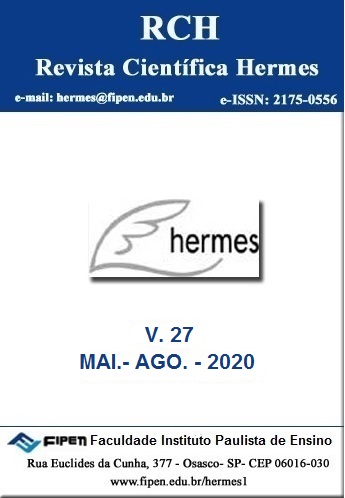Built for practical use of red flags in audit
DOI:
https://doi.org/10.21710/rch.v27i0.503Keywords:
Financial basis, Non-financial basis, Errors, Fraud, Auditing.Abstract
The accounting audit is undergoing changes to keep up with the needs imposed by market developments. Therefore, as a descriptive study supported by the theory of Albrecht e Romney (1986), on the use of red flags on financial and operational bases as a form of fraud detection, this work had as objective the construction of a practical model, originating a new software, which supported the Cronbach test, validated the internal consistency of the pairs of red flags presented according to their scope, for later, based on the method of Bardin (1991), identify and correlate financial and operational variables. The application of the model / software took place in the financial statements and reports of the five largest Brazilian public companies, chosen for convenience, in view of the corruption processes that are linked. As a result, we obtained the crossing of the red flags shown Figure 1, which represent signs of errors or fraud in the analyzed companies, signaling to the audit, that these points deserve attention, according to the theoretical and legal framework consulted. This was the main contribution of the model and software, which should be used as a way of understanding complementary to existing methods, expanding the possibility of analysis due to the potential of information processing.
Â
References
Albrecht, S. & Romney, M. (1986). Red-flagging management fraud: a validation. Advances in Accounting,3, 323-333.
Albrecht, S. (2003). Fraud Examination. São Paulo: Thomson.
Association of certified fraud examiners. ACFE. (2016). - Educação formação e certificação fraude. Recuperado de http://www.acfe.com/default.aspx.
Appolinário, F. (2011). Dicionário de metodologia científica. São Paulo: Atlas.
Bardin,L. (1991). Análise de Conteúdo. Lisboa: Edições 70
Bell, T. & Carcacello, J. (2000). A decision aid for accessing the likehood of fraudulent financial reporting. Auditing: A Journal of Practice & Theory, 19(1).
Cressey, D. R. (1953). Other people's money: a studyin the social psychology of embezzlement. [S.l.:s.n.].
De Sá, A. L. D. & Hoog, W. A. Z. (2012). Corrupção, fraude e contabilidade. Rio de Janeiro: Jurua.
Eining, M. Jones, D. & Loebbecke, J. (1997). Reliance on decision aids: an examination of auditor’s assessment of management fraud. Auditing: A Journal of practice & theory, 16(2), 1-19.
Esteves, I. I. S. (2012). A Responsabilidade social do auditor perante a fraude. Lisboa: Instituto Politécnico de Lisboa.
Gil, A. C. (1996). Como elaborar projetos de pesquisa. São Paulo: Atlas.
Ibracon. (2016). Recuperado em set. 2020, de http://www.ibracon.com.br/ibracon/Portugues/detInstitucional.php?cod=1.
Kranacher, M., Riley, R., & Wells, J. T. (2010). Forensic Accounting And Fraud Examination. Saint Louis: John Wiley.
Moura, H. S. (2004). Auditoria de fraude: instrumentos na prevençãode fraudes contra as empresas. Congresso de Contabilidade – Relato Financeiro e Responsabilidade Social, Florianópolis, Brasil.
Moura, D. (2007). Análise dos fatores de convencimento do juízo brasileiro quanto à ocorrência de fraude contábil: um estudo de caso múltiplo da Gallus, da Encol e do Banco Santos. (Dissertação de mestrado) para conclusão do Mestrado Internacional (MIM), Fundação Getúlio Vargas, Rio de Janeiro, Brasil.
MPF (2017). Recuperado de http://lavajato.mpf.mp.br/entenda-o-caso.
Murcia, F. D. & Borba, J. A. (2007). Estrutura para detecção do risco de fraude nas demonstrações contábeis: mapeando o ambiente fraudulento. Brazilian Business Review, 12(3), 171-190.
Murcia, F. D. Borba, J. A. & Schiehll, E. (2008). Relevância dos red flags na avaliação do risco de fraudes nas demonstrações contábeis: a percepção dos auditores independentes brasileiros. Universo Contábil, 17, 25-45.
Reinstein, A. & Mcmillan, J. (2004). The Enron debate: more than a perfect storm. Critical Perspectives on Accounting. Article in the press.
Ricardino, Á. & Carvalho, L. N. (2004). Breve retrospectiva do desenvolvimento das atividades de auditoria no brasil. Revista Contabilidade & Finanças, 16, 22-34.
Souza, A. J. (2012). Normas internacionais de contabilidade: percepções dos peritos criminais federais sobre os impactos de sua adoção na atividade de perícia oficial realizada em fraudes contábeis no Brasil. Brazilian Business Review, 19(1), 53-72.
Stickney, C. & Weil, R. (2000). Financial accounting: an introduction to concepts, methods and uses. New York: Dryden.
Wells, J. (2005). Principles of fraud examination. New York: Wiley.
Wuerges, A. F. E. (2010). Detecção de fraudes contábeis: é possível quantificar os casos não-descobertos? Universo Contábil, 23. 25-54.
Downloads
Published
How to Cite
Issue
Section
License
Copyright (c) 2020 Revista CientÃfica Hermes - FIPEN

This work is licensed under a Creative Commons Attribution 4.0 International License.






